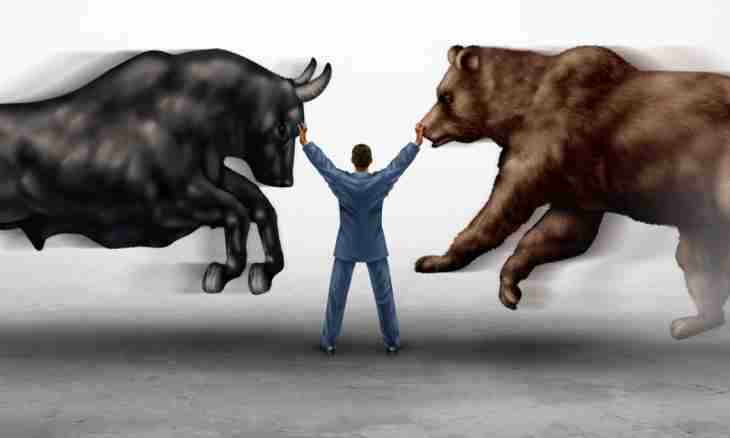Profitable operations on the stock exchange can be made both on growing, and in the falling market. Depending on the chosen strategy of trade of participants of the market it is accepted to divide into two categories. On a slang of the exchange they are called "bulls" and "bears". The "bull" market is characterized by the growing cost of securities.
Strategy of stock market game
All attention of exchange players is riveted on the prices of stock and other securities which are quoted in the market. For receiving profit not the absolute asset price, but its change in time matters. The stock market is in the movement all the time. Some papers become more expensive, others go down in price. These fluctuations during the period chosen for trade can be very essential. The difference in the prices is higher, the exchange speculators can get big profit.
The easiest way to profit from an exchange difference – to buy assets at the lowest price, to wait when their market value grows then to sell. Players who use such strategy on a professional slang are called "bulls", and a trend in the market at which share price grows, – a "bull" trend. As traders speak, "bull" with confidence rises up a ladder.
The market can be developed at any time in an opposite direction. It is possible to get profit and at reduction of price of assets. For this purpose it is required to make at the right time sale of securities, to wait when their cost falls to a minimum then to close the transaction, having made purchase. Those who adhere to similar strategy at the exchange are called "bears". The "bear" trend demands bigger discretion as it is noticed that the stock market usually falls more promptly, than grows.
Features of a "bychy" trend
The market elements are unpredictable though experienced traders develop own strategies of trade which at successful combination of circumstances can make considerable profit. For forecasting of the changes in price both "bulls", and "bears" use data of the fundamental and technical analysis. It should be noted that in the market there is also special state when the price throughout a long time almost does not change. Such trend is called a "side" trend. The task of "bull" is in drawing the correct conclusion on a condition of the market, having caught its movement up. If the "bull" trend comes nearer, the number of requests for purchase of assets grows. Violation of balance finds reflection in so-called figures of a turn which can more or less clearly be observed on graphics of a rate of certain security. When there is a similar signal demonstrating the forthcoming advance in price, "bulls" immediately start purchase of assets, trying not to miss this moment. The "bull" trend on the course schedule is not similar to a straight line, surely and steadily rising up. The price usually grows not linearly, and jumps. Rather long market growth periodically is replaced by small kickback down or a side trend. The trader should make all the time the decision on at what moment it is necessary to lock in profits and to leave the market. Recession of the price sometimes means that there came small correction, but can demonstrate also that the long "bear" trend on which "bulls" can suffer losses begins. Only the experience multiplied by cold mind helps to make the correct decision.

